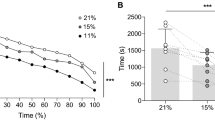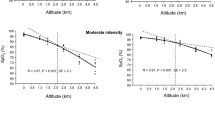Abstract
Purpose
This study investigated the response of the ventilatory threshold (VT) to acute normobaric hypoxia and compared the agreement between software-based algorithms which use automatic detection to identify the VT. Results were used to examine whether the VT can be used as a physiological parameter to prescribe and monitor exercise intensity in hypoxic exercise training programs.
Methods
Fourteen untrained individuals (7 women, 7 men; age 22 ± 2 years, \(\dot{V}\)O2peak 46 ± 7 mL kg−1 min−1) completed five identical graded exercise tests (randomized order) on a cycle ergometer to measure VT at sea-level (SL) and in response to four normobaric hypoxic conditions (FIO2: 0.185, 0.165, 0.142, 0.125) equivalent to 1,000, 2,000, 3,000 and 4,000 m. Data were analyzed using a one-way analysis of variance (ANOVA) with repeated measures.
Results
The VT was similar across all conditions (SL = 1.98 ± 0.46, 1,000 m = 2.03 ± 0.61, 2,000 m = 2.27 ± 0.62, 3,000 m = 1.84 ± 0.50, 4,000 m = 2.29 ± 0.58 L min−1) for all algorithms used despite a reduction in arterial oxygen saturation at 3,000 (P ≤ 0.01) and 4,000 m (P ≤ 0.01) compared with SL values.
Conclusion
The VT appears to be a suitable physiological parameter for exercise prescription in normobaric hypoxia up to an altitude of 4,000 m.



Similar content being viewed by others
Abbreviations
- ANOVA:
-
Analysis of variance
- FIO2 :
-
Ambient inspiratory oxygen fractions
- GXT:
-
Graded exercise test
- H+ :
-
Hydrogen ion
- HR:
-
Heart rate
- HRpeak :
-
Peak heart rate
- HRVT :
-
Heart rate at ventilatory threshold
- RCP:
-
Respiratory compensation point
- RH:
-
Relative humidity
- RPE:
-
Rating of perceived exertion
- SD:
-
Standard deviation
- SL:
-
Sea-level
- SPO2 :
-
Arterial oxygen saturation measured using infrared pulse oximetry
- t amb :
-
Ambient temperature
- \(\dot{V}\)CO2 :
-
Rate of carbon dioxide production
- \(\dot{V}\)Epeak :
-
Peak rate of ventilation
- \(\dot{V}\)O2 :
-
Oxygen consumption
- \(\dot{V}\)O2 :
-
Rate of oxygen consumption
- \(\dot{V}\)O2peak :
-
Peak rate of oxygen consumption
- \(\dot{V}\)O2VT :
-
Rate of oxygen consumption at ventilatory threshold
- \(\dot{W}\) peak :
-
Peak power output
- VT:
-
Ventilatory threshold
- W VT :
-
Power at ventilatory threshold
References
Amann M, Kayser B (2009) Nervous system function during exercise in hypoxia. High Alt Med Biol 10(2):149–164
Amann M, Subudhi AW, Foster C (2006) Predictive validity of ventilatory and lactate thresholds for cycling time trial performance. Scand J Med Sci Sports 16(1):27–34
Beaver WL, Wasserman K, Whipp BJ (1986) A new method for detecting anaerobic threshold by gas exchange. J Appl Physiol 60(6):2020–2027
Benoit H, Busso T, Castells J, Geyssant A, Denis C (2003) Decrease in peak heart rate with acute hypoxia in relation to sea level VO2max. Eur J Appl Physiol 90(5–6):514–519
Bompa TO, Haff GG (2009) Periodisation: theory and methodology of training, 5th edn. Human Kinetics, Leeds
Borg GAV (1982) Psychophysical bases of perceived exertion. Med Sci Sports Exerc 14(5):377–381
Bosquet L, Leger L, Legros P (2002) Methods to determine aerobic endurance. Sports Med 32(11):675–700
Calbet JA, Boushel R, Radegran G, Sondergaard H, Wagner PD, Saltin B (2003) Determinants of maximal oxygen uptake in severe acute hypoxia. Am J Physiol Regul Integr Comp Physiol 284(2):R291–R303
Carter H, Jones AM, Doust JH (1999) Effect of six weeks of endurance training on the lactate minimum speed. J Sports Sci 17:957–967
Cerretelli P (1980) Gas exchange at high altitude. In: West JB (ed) Pulmonary gas exchange, vol 1. Academic Press, New York, pp 97–147
Chapman RF, Emery M, Stager JM (1999) Degree of arterial desaturation in normoxia influences VO2max decline in mild hypoxia. Med Sci Sports Exerc 31(5):658–663
Cheng B, Kuipers H, Snyder AC, Keizer HA, Jeukendrup A, Hesselink M (1992) A new approach for the determination of ventilatory and lactate thresholds. Int J Sports Med 13(7):518–522
Cohen J (1988) Statistical power analysis for the behavioral sciences, 2nd edn. Routledge, New York
Cohen J (1992) A power primer. Psychol Bull 112(1):155–159
Davis JA (1985) Anaerobic threshold—review of the concept and directions for future-research. Med Sci Sports Exerc 17(1):6–18
Dickstein K, Barvik S, Aarsland T, Snapinn S, Millerhagen J (1990) Validation of a computerised technique for detection of the gas exchange anaerobic threshold in cardiac disease. Am J Cardiol 66:1363–1367
Ekkekakis P, Lind E, Hall EE, Petruzzello SJ (2008) Do regression-based computer algorithms for determining the ventilatory threshold agree? J Sports Sci 26(9):967–976
Ferretti G, Moia C, Thomet JM, Kayser B (1997) The decrease of maximal oxygen consumption during hypoxia in man: a mirror image of the oxygen equilibrium curve. J Physiol 498(1):231–237
Field A (2005) Discovering statistics using SPSS, 2nd edn. Sage, London, p 294
Friedmann B, Bauer T, Menold E, Bartsch P (2004) Exercise with the intensity of the individual anaerobic threshold in acute hypoxia. Med Sci Sports Exerc 36(10):1737–1742
Friedmann B, Frese F, Menold E, Bartsch P (2005) Individual variation in the reduction of heart rate and performance at lactate thresholds in acute normobaric hypoxia. Int J Sports Med 26(7):531–536
Fukuoka Y, Endo M, Oishi Y, Ikegami H (2003) Chemoreflex drive and the dynamics of ventilation and gas exchange during exercise at hypoxia. Am J Respir Crit Care Med 168(9):1115–1122
Gaskill SE, Ruby BC, Walker AJ, Sanchez OA, Serfass RC, Leon AS (2001) Validity and reliability of combining three methods to determine ventilatory threshold. Med Sci Sports Exerc 33:1841–1848
Gore CJ, Hahn AG, Scroop GC, Watson DB, Norton KI, Wood RJ et al (1996) Increased arterial desaturation in trained cyclists during maximal exercise at 580 m altitude. J Appl Physiol 80(6):2204–2210
Haufe S, Wiesner S, Engeli S, Luft FC, Jordan J (2008) Influences of normobaric hypoxia training on metabolic risk markers in human subjects. Med Sci Sports Exerc 40(11):1939–1944
Hughson RL, Green HJ, Sharratt MT (1995) Gas-exchange, blood lactate, and plasma-catecholamines during incremental exercise in hypoxia and normoxia. J Appl Physiol 79(4):1134–1141
Jones AM, Carter H (2000) The effect of endurance training on parameters of aerobic fitness. Sports Med 29(6):373–386
Jones RH, Molitoris BA (1984) A statistical method for determining the breakpoint of two lines. Anal Biochem 141(1):287–290
Kent M (2007) The Oxford dictionary of sports science and medicine, 3rd edn. Oxford University Press, Oxford
Keppel G (1983) Design and analysis: a researchers handbook. Prentice Hall, London
Lawler J, Powers SK, Thompson D (1988) Linear relationship between Vo2 max and Vo2 max decrement during exposure to acute-hypoxia. J Appl Physiol 64(4):1486–1492
Lucia A, Hoyos J, Perez M, Santalla A, Earnest CP, Chicharro JL (2004) Which laboratory variable is related with time trial performance time in the Tour de France? Br J Sports Med 38(5):636–640
Mateika JH, Duffin J (1994) The ventilation, lactate and electromyographic thresholds during incremental exercise tests in normoxia, hypoxia and hyperoxia. Eur J Appl Physiol 69(2):110–118
Mazzeo RS, Bender PR, Brooks GA, Butterfield GE, Groves BM, Sutton JR et al (1991) Arterial catecholamine responses during exercise with acute and chronic high-altitude exposure. Am J Physiol 261(4):E419–E424
Netzer NC, Chytra R, Kupper T (2008) Low intense physical exercise in normobaric hypoxia leads to more weight loss in obese people than low intense physical exercise in normobaric sham hypoxia. Sleep Breath 12(2):129–134
Noonan V, Dean E (2000) Submaximal exercise testing: clinical application and interpretation. Phys Ther 80(8):782–807
Orr GW, Green HJ, Hughson RL, Bennett GW (1982) A computer linear regression model to determine ventilatory anaerobic threshold. J Appl Physiol: Respir Environ Exerc Physiol 52(5):1349–1352
Overgaard M, Rasmussen P, Bohm AM, Seifert T, Brassard P, Zaar M et al (2012) Hypoxia and exercise provoke both lactate release and lactate oxidation by the human brain. FASEB J 26(7):3012–3020
Ozcelik O, Kelestimur H (2004) Effects of acute hypoxia on the estimation of lactate threshold from ventilatory gas exchange indices during an incremental exercise test. Physiol Res 53(6):653–659
Quintero P, Milagro FI, Campion J, Martinez JA (2010) Impact of oxygen availability on body weight management. Med Hypotheses 74(5):901–907
Roach RC, Maes D, Sandoval D, Robergs RA, Icenogle M, Hinghofer-Szalkay H et al (2000) Exercise exacerbates acute mountain sickness at simulated high altitude. J Appl Physiol 88(2):581–585
Rosenthal R, Rosnow RL, Rubin DB (2000) Contrasts and effect sizes in behavioral research: a correlational approach. Cambridge University Press, New York, p 32
Santos EL, Giannella-Neto A (2004) Comparison of computerized methods for detecting the ventilatory thresholds. Eur J Appl Physiol 93(3):315–324
Stenberg J, Ekblom B, Messin R (1966) Hemodynamic response to work at simulated altitude, 4,000 m. J Appl Physiol 21(5):1589–1594
Subudhi AW, Jacobs KA, Hagobian TA, Fattor JA, Muza SR, Fulco CS et al (2006) Changes in ventilatory threshold at high altitude: effect of antioxidants. Med Sci Sports Exerc 38(8):1425–1431
Sue DY, Wasserman K, Moricca RB, Casaburi R (1988) Metabolic acidosis during exercise in patients with chronic obstructive pulmonary disease: use of the V-slope method for anaerobic threshold determination. Chest 94(5):931–938
Wasserman K, McIlroy MB (1964) Detecting the threshold of anaerobic metabolism in cardiac patients during exercise. American J Cardiol 14:844–852
Wehrlin JP, Hallen J (2006) Linear decrease in VO2max and performance with increasing altitude in endurance athletes. Eur J Appl Physiol 96(4):404–412
Wells C, Pate R (1988) Training and performance of prolonged exercise. Perspect Exerc Sci Sports Med 1:357–391
Weltman A, Seip RL, Snead D, Weltman JY, Haskvitz EM, Evans WS et al (1992) Exercise training at and above the lactate threshold in previously untrained women. Int J Sports Med 13(3):257–263
Yeh MP, Gardner RM, Adams TD, Yanowitz FG, Crapo RO (1983) Anaerobic threshold: problems of determination and validation. J Appl Physiol 55(4):1178–1186
Acknowledgments
There were no external funding sources used in the preparation of this article. C A Gallagher is currently receiving financial support in the form of a bursary allowance from the University of Chichester.
Conflict of interest
There is no conflict of interests concerning the preparation of this article.
Author information
Authors and Affiliations
Corresponding author
Additional information
Communicated by Carsten Lundby.
Rights and permissions
About this article
Cite this article
Gallagher, C.A., Willems, M.E.T., Lewis, M.P. et al. Effect of acute normobaric hypoxia on the ventilatory threshold. Eur J Appl Physiol 114, 1555–1562 (2014). https://doi.org/10.1007/s00421-014-2882-1
Received:
Accepted:
Published:
Issue Date:
DOI: https://doi.org/10.1007/s00421-014-2882-1




